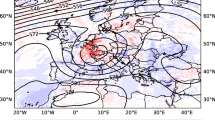Abstract
The analysis of the daily rainfall occurrence behavior is becoming more important, particularly in water-related sectors. Many studies have identified a more comprehensive pattern of the daily rainfall behavior based on the Markov chain models. One of the aims in fitting the Markov chain models of various orders to the daily rainfall occurrence is to determine the optimum order. In this study, the optimum order of the Markov chain models for a 5-day sequence will be examined in each of the 18 rainfall stations in Peninsular Malaysia, which have been selected based on the availability of the data, using the Akaike’s (AIC) and Bayesian information criteria (BIC). The identification of the most appropriate order in describing the distribution of the wet (dry) spells for each of the rainfall stations is obtained using the Kolmogorov-Smirnov goodness-of-fit test. It is found that the optimum order varies according to the levels of threshold used (e.g., either 0.1 or 10.0 mm), the locations of the region and the types of monsoon seasons. At most stations, the Markov chain models of a higher order are found to be optimum for rainfall occurrence during the northeast monsoon season for both levels of threshold. However, it is generally found that regardless of the monsoon seasons, the first-order model is optimum for the northwestern and eastern regions of the peninsula when the level of thresholds of 10.0 mm is considered. The analysis indicates that the first order of the Markov chain model is found to be most appropriate for describing the distribution of wet spells, whereas the higher-order models are found to be adequate for the dry spells in most of the rainfall stations for both threshold levels and monsoon seasons.





Similar content being viewed by others
References
Akaike H (1974) A new look at the statistical model identification. IEEE Trans Automat Contr 19:716–723
Anagnostopoulou CHR, Maheras P, Karacostas T, Vafiadis M (2003) Spatial and temporal analysis of dry spells in Greece. Theor Appl Climatol 74(1–2):77–91
Basu AN (1971) Fitting of a Markov chain model for daily rainfall data at Calcutta. Indian J Meteorol Geophys 22:67–74
Berger A, Goosens C (1983) Persistence of wet and dry spells at Uccle (Belgium). J Climatol 3:21–34
Besson L (1924) On the probability of rain. Mon Wea Rev 52:308
Camerlengo AL (1999) Monthly frequency distributions of both dry spells and the number of days with precipitation greater than 25 mm over Peninsular Malaysia. GEOACTA 23:1–18
Chapman TG (1997) Stochastic models for daily rainfall in the Western Pacific. Math Comput Simul 43(3):351–358
Chin EH (1977) Modeling daily precipitation occurrence process in Markov chain. Water Resour Res 13(6):949–956
Dahale SD, Panchawagh N, Singh SV, Ranatunge ER, Brikshavana M (1994) Persistence in Rainfall Occurrence over Tropical South East Asia and Equatorial Pacific. Theor Appl Climatol 49:27–39
Dale WL (1960) The rainfall of Malaya, part II. J Trop Geogr 14:11–28
Deni SM, Jemain AA, Ibrahim K (2008) The spatial distribution of wet and dry spells over Peninsular Malaysia. Theor Appl Climatol (in press). doi:10.1007/s00704-007-0355-8
Eriksson B (1965) A climatological study of persistency and probability of precipitation in Sweden. Tellus 17:484–497
Fleming SW (2007) Climatic influences on Markovian transition matrices for Vancouver daily rainfall occurrence. Atmos Ocean 45(3):163–171
Gabriel KR, Neumann J (1962) A Markov chain model for daily rainfall occurrence at Tel Aviv. Quart J Roy Meteorol Soc 88:90–95
Gates F, Tong H (1976) On Markov chain modeling to some weather data. J Appl Meteorol 15:1145–1151
Harrison M, Waylen P (2000) A note concerning the proper choice for Markov model order for daily precipitation in the humid tropics: a case study in Costa Rica. Int J Climatol 20:1861–1872
Hayhoe HN (2000) Improvements of stochastic weather data generators for diverse climates. Clim Res 14:75–87
Hui W, Xuebin Z, Elaine MB (2005) Stochastic modeling of daily precipitation for Canada. Atmos Ocean 43(1):23–32
Jimoh OD, Webster P (1996) Optimum order of Markov chain for daily rainfall in Nigeria. J Hydrol 185:45–69
Katz RW (1981) On some criteria for estimating the order of Markov chain. Technometrics 23:243–249
Kottegoda NT, Natale L, Raiteri E (2004) Some considerations of periodicity and persistence in daily rainfalls. J Hydrol 296:23–37
Lim JT (1976) Rainfall minimum in Peninsular Malaysia during the Northeast monsoon. Mon Wea Rev 104:96–99
Martin-Vide J, Gomez L (1999) Regionalization of Peninsular Spain based on the length of dry spells. Int J Climatol 19:537–555
Moon SE, Ryoo SB, Kwon JG (1994) A Markov chain model for daily precipitation occurrence in South Korea. Int J Climatol 14(9):1009–1016
Quah LC, Ooi MK (1985) Wet and dry spell probability models in West Malaysia. Research Publication no. 14. Malaysian Meteorological Service, Petaling Jaya, Malaysia
Schwarz G (1978) Estimating the dimension of a model. Ann Stat 6:461–464
Singh SV, Kripalani RH, Priya S, Ismail PMM, Dahale SD (1981) Persistence in daily and 5-day summer monsoon rainfall over India. Arch Meteor Geophys Bioclim Ser A 30:261–277
Stern RD, Coe R (1984) A model fitting analysis of daily rainfall data. J R Stats Soc A 147(1):1–34
Tolika K, Maheras P (2005) Spatial and temporal characteristics of wet spells in Greece. Theor Appl Climatol 81(1–2):71–85
Tong H (1975) Determination of the order of a Markov chain by Akaike’s information criterion. J Appl Prob 12:488–497
Wilks DS (1995) Statistical methods in atmospheric sciences: an introduction. Academic, London
Wilks DS (1999) Interannual variability and extreme-value characteristics of several stochastic daily precipitation models. Agric For Meteorol 93(3):153–169
Acknowledgements
The authors are indebted to the staff of the Malaysian Meteorological Services for providing the daily rainfall data for this study. They also acknowledge their sincere appreciation to both reviewers for their valuable suggestions and remarks in improving this manuscript.
Author information
Authors and Affiliations
Corresponding author
Rights and permissions
About this article
Cite this article
Deni, S.M., Jemain, A.A. & Ibrahim, K. Fitting optimum order of Markov chain models for daily rainfall occurrences in Peninsular Malaysia. Theor Appl Climatol 97, 109–121 (2009). https://doi.org/10.1007/s00704-008-0051-3
Received:
Accepted:
Published:
Issue Date:
DOI: https://doi.org/10.1007/s00704-008-0051-3




